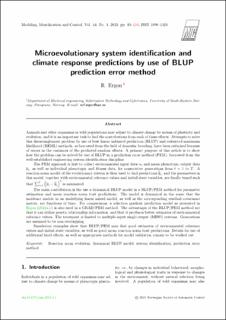| dc.contributor.author | Ergon, Rolf | |
| dc.date.accessioned | 2023-09-27T08:53:17Z | |
| dc.date.available | 2023-09-27T08:53:17Z | |
| dc.date.created | 2023-09-19T09:41:04Z | |
| dc.date.issued | 2023 | |
| dc.identifier.citation | Ergon, R. (2023). Microevolutionary system identification and climate response predictions by use of BLUP prediction error method. MIC Journal: Modeling, Identification and Control, 44(3), 83-110. | en_US |
| dc.identifier.issn | 0332-7353 | |
| dc.identifier.uri | https://hdl.handle.net/11250/3092271 | |
| dc.description.abstract | Animals and other organisms in wild populations may adjust to climate change by means of plasticity and evolution, and it is an important task to find the contributions from each of these effects. Attempts to solve this disentanglement problem by use of best linear unbiased prediction (BLUP) and restricted maximum likelihood (REML) methods, as borrowed from the field of domestic breeding, have been criticized because of errors in the variances of the predicted random effects. A primary purpose of this article is to show how the problem can be solved by use of BLUP in a prediction error method (PEM), borrowed from the well-established engineering system identification discipline. The PEM approach is first to collect environmental input data and mean phenotypic output data, as well as individual phenotypic and fitness data, for consecutive generations. A reaction norm model of the evolutionary system is then used to find predictions and the parameters in this model, together with environmental reference values and initial state variables, are finally tuned. The main contribution is the use a dynamical BLUP model in a BLUP/PEM method for parameter estimation and mean reaction norm trait predictions. The model is dynamical in the sense that the incidence matrix in an underlying linear mixed model, as well as the corresponding residual covariance matrix, are functions of time. For comparisons, a selection gradient prediction model as presented in Ergon (2022a,b) is also used in a GRAD/PEM method. The advantages of the BLUP/PEM method are that it can utilize genetic relationship information, and that it produces better estimates of environmental reference values. The treatment is limited to multiple-input single-output (MISO) systems. Generations are assumed to be non-overlapping. Simulation examples show that BLUP/PEM may find good estimates of environmental reference values and initial state variables, as well as good mean reaction norm trait predictions. Details for use of additional fixed effects, as well as appropriate methods for model validation remain to be worked out. | en_US |
| dc.language.iso | eng | en_US |
| dc.relation.uri | https://www.mic-journal.no/PDF/2023/MIC-2023-3-1.pdf | |
| dc.rights | Navngivelse 4.0 Internasjonal | * |
| dc.rights.uri | http://creativecommons.org/licenses/by/4.0/deed.no | * |
| dc.title | Microevolutionary system identification and climate response predictions by use of BLUP prediction error method | en_US |
| dc.type | Peer reviewed | en_US |
| dc.type | Journal article | en_US |
| dc.description.version | publishedVersion | en_US |
| dc.rights.holder | © 2023 Norwegian Society of Automatic Control. | en_US |
| dc.source.pagenumber | 83-110 | en_US |
| dc.source.volume | 44 | en_US |
| dc.source.journal | MIC Journal: Modeling, Identification and Control | en_US |
| dc.source.issue | 3 | en_US |
| dc.identifier.doi | https://doi.org/10.4173/mic.2023.3.1 | |
| dc.identifier.cristin | 2176330 | |
| cristin.ispublished | true | |
| cristin.fulltext | original | |
| cristin.qualitycode | 1 | |

